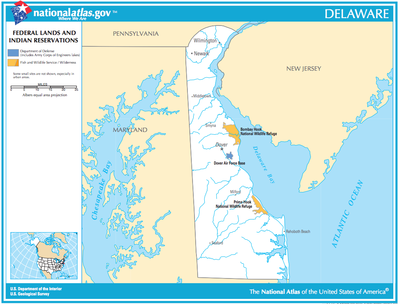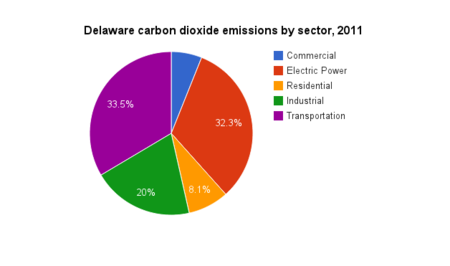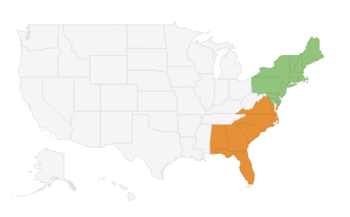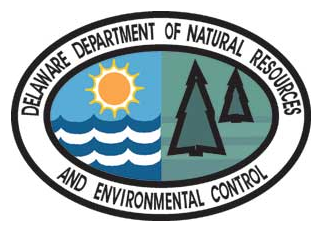This Giving Tuesday, help ensure voters have the information they need to make confident, informed decisions. Donate now!
Historical Delaware environmental information, 1971-2016
![]() This article does not contain the most recently published data on this subject. If you would like to help our coverage grow, consider donating to Ballotpedia.
This article does not contain the most recently published data on this subject. If you would like to help our coverage grow, consider donating to Ballotpedia.
The historical environmental information below applies to prior years. For more current information regarding environmental policy in Delaware, see this article.
Land ownership
- See also: Federal land policy and Federal land ownership by state
The federal government owned between 635 million and 640 million acres of land in 2012 (about 28 percent) of the 2.27 billion acres of land in the United States. Around 52 percent of federally owned acres were in 12 Western states—including Alaska, 61 percent of which was federally owned. In contrast, the federal government owned 4 percent of land in the other 38 states. Federal land policy is designed to manage minerals, oil and gas resources, timber, wildlife and fish, and other natural resources found on federal land. Land management policies are highly debated for their economic, environmental and social impacts. Additionally, the size of the federal estate and the acquisition of more federal land are major issues.[1][2]
Delaware is located in the Mid-Atlantic region of the United States. According to the Congressional Research Service, the state of Delaware has a total acreage of 1,265,920 acres. Of that total, 2.26 percent, or 28,574 acres, belongs to the federal government. From 1990 to 2010, the federal government increased its ownership of land in Delaware by 843 acres. The federal government owns between 635 million to 640 million acres nationwide, or 28 percent of the estimated 2.27 billion acres in the nation. More than 1.2 million acres in Delaware are not owned by the federal government, which works out to an average of 1.3 acres per capita for the state's 925,749 million residents.[1]
The table below shows federal land ownership in Delaware compared to a neighboring state and a western state, as a comparison.
| Federal land ownership in Delaware and other states by agency | |||||||||||
|---|---|---|---|---|---|---|---|---|---|---|---|
| State | |||||||||||
| Agency | Delaware | Maryland | Utah | ||||||||
| Acres owned | Percentage owned | Acres owned | Percentage owned | Acres owned | Percentage owned | ||||||
| U.S. Forest Service | 0 | 0.00% | 0 | 0.00% | 8,207,415 | 23.43% | |||||
| U.S. National Park Service | 0 | 0.00% | 40,543 | 20.69% | 2,097,106 | 5.99% | |||||
| U.S. Fish and Wildlife Service | 25,100 | 87.84% | 46,504 | 23.73% | 107,885 | 0.31% | |||||
| U.S. Bureau of Land Management | 0 | 0.00% | 548 | 0.28% | 22,854,937 | 65.24% | |||||
| U.S. Department of Defense | 3,474 | 12.16% | 108,391 | 55.31% | 1,766,260 | 5.04% | |||||
| Total federal land | 28,574 | 100% | 195,986 | 100% | 35,033,603 | 100% | |||||
| Source: Congressional Research Service, "Federal Land Ownership: Overview and Data" | |||||||||||
Land usage
Recreation
National parks in Delaware
Delaware has one national park, one national monument and two national historic trails. There are also 15 state parks managed by the Delaware Division of Parks and Recreation.[3][4]
State recreation lands
The table below contains a list of the 15 state parks in Delaware.[5]
| State parks in Delaware | ||||||
|---|---|---|---|---|---|---|
| State park name | ||||||
| Bellevue State Park | ||||||
| Fort Delaware State Park | ||||||
| Fort DuPont State Park | ||||||
| Cape Henlopen State Park | ||||||
| Delaware Seashore State Park | ||||||
| Fenwick Island State Park | ||||||
| Holts Landing State Park | ||||||
| Lums Pond State Park | ||||||
| Killens Pond State Park | ||||||
| Trap Pond State Park | ||||||
| White Clay Creek State Park | ||||||
| Brandywine Creek State Park | ||||||
| Fox Point State Park | ||||||
| Wilmington State Park | ||||||
| Alapocas Run State Park | ||||||
Economic activity on federal lands
Oil and gas activity
- See also: BLM oil and gas leases by state
Private mining companies, including oil and natural gas companies, can apply for leases from the U.S. Bureau of Land Management (BLM) to explore and produce energy on federal land. The company seeking a lease must nominate the land for oil and gas exploration to the BLM, which evaluates and approves the lease. The BLM state offices make leasing decisions based on their land use plans, which contain information on the land's resources and the potential environmental impact of oil or gas exploration. If federal lands are approved for leasing, the BLM requires an application from the company containing information on how the exploration, drilling and production will be conducted. Afterward, the BLM will produce an environmental analysis and a list of requirements before work on the land can begin. The agency also inspects the companies' drilling and producing on the leased lands.[6]
In 2013, there were 47,427 active leases covering 36.09 million acres of federal land nationwide. As of 2013, there were no active leases in Delaware. In 2013, out of 3,770 new drilling leases approved nationwide by the BLM for oil and gas exploration, no leases were in Delaware.[7][8][9][10][11]
The table below shows how Delaware compared to neighboring states in oil and gas permits on BLM-managed lands in 2013.
| Oil and gas leasing on BLM lands by state | |||||||||
|---|---|---|---|---|---|---|---|---|---|
| State | Active permits on BLM lands (FY 2013) | Total acres under lease (FY 2013) | State percentage of total permits | State percentage of total acres | |||||
| Delaware | 0 | 0 | 0.00% | 0.00% | |||||
| Maryland | 4 | 2,632 | 0.01% | 0.01% | |||||
| Pennsylvania | 69 | 4,761 | 0.15% | 0.01% | |||||
| Virginia | 39 | 28,547 | 0.08% | 0.08% | |||||
| West Virginia | 257 | 119,883 | 0.54% | 0.33% | |||||
| Total United States | 47,427 permits | 36,092,482 acres | - | - | |||||
| Source: U.S. Bureau of Land Management | |||||||||
Payments in lieu of taxes
- See also: Payments in lieu of taxes
Since local governments cannot collect taxes on federally owned property, the U.S. Department of the Interior issues payments to local governments to replace lost property tax revenue from federal land. The payments, known as "Payments in Lieu of Taxes" (PILTs), are typically used for funding services such as fire departments, police protection, school construction and roads.[12]
The table below shows PILTs for Delaware compared to neighboring states between 2011 and 2013.
| Total PILTs for Delaware and neighboring states | ||||||
|---|---|---|---|---|---|---|
| State | FY 2011 | FY 2012 | FY 2013 | State's percentage of 2013 total | ||
| Delaware | $17,897 | $18,268 | $17,828 | 0.00% | ||
| Maryland | $99,852 | $102,393 | $99,591 | 0.02% | ||
| Pennsylvania | $539,161 | $610,842 | $685,575 | 0.17% | ||
| Virginia | $2,791,489 | $3,113,070 | $3,263,807 | 0.81% | ||
| West Virginia | $2,863,940 | $2,953,219 | $2,892,560 | 0.72% | ||
| Source: U.S. Department of the Interior, "PILT" | ||||||
Legislation and regulation
Federal laws
Clean Air Act
The federal Clean Air Act requires each state to meet federal standards for air pollution. Under the act, the U.S. Environmental Protection Agency oversees national air quality standards aimed at limiting pollutants from chemical plants, steel mills, utilities, and industrial factories. Individual states can enact stricter air standards if they choose, though each state must adhere to the EPA's minimum pollution standards. States implement federal air standards through a state implementation plan (SIP), which must be approved by the EPA.[13]
Clean Water Act
The federal Clean Water Act is meant to address and maintain the physical, chemical, and biological status of the waters of the United States. The U.S. Environmental Protection Agency (EPA) regulates water pollution sources and provides financial assistance to states and municipalities for water quality programs.[14]
According to research done by The New York Times using annual averages from 2004 to 2007, Delaware had 56.5 facilities that were regulated annually by the Clean Water Act. An average of 13.4 facilities violated the act annually from 2004 to 2007 in Delaware, and the EPA enforced the act an average of 1.1 times a year in the state. This information, published by the Times in 2009, was the most recent information on the subject as of October 2014.[15]
The table below shows how Delaware compared to neighboring states in The New York Times study, including the number of regulated facilities, facility violations, and the annual average of enforcement actions against regulated facilities between 2004 and 2007.
| The New York Times Clean Water Act study (2004-2007) | |||
|---|---|---|---|
| State | Number of facilities regulated | Facility violations | Annual average enforcement actions |
| Delaware | 56.5 | 13.4 | 1.1 |
| Maryland | 612.5 | 154.8 | 55.8 |
| Pennsylvania | 4,355.0 | 392.2 | 20.3 |
| Virginia | 1,120.0 | 147.8 | 37.0 |
| West Virginia | 799.3 | 258.0 | 71.3 |
Endangered Species Act
The federal Endangered Species Act (ESA) of 1973 provides for the identification, listing, and protection of both threatened and endangered species and their habitats. According to the U.S. Fish and Wildlife Service, the law was designed to prevent the extinction of vulnerable plant and animal species through the development of recovery plans and the protection of critical habitats. ESA administration and enforcement are the responsibility of the U.S. Fish and Wildlife Service and the National Marine Fisheries Service.[16][17]
Federally listed species in Delaware
There were 17 endangered and threatened animal and plant species believed to or known to occur in Delaware as of July 2015.
The table below lists the 12 endangered and threatened animal species believed to or known to occur in the state. When an animal species has the word "Entire" after its name, that species will be found all throughout the state.[18]
| Endangered animal species in Delaware | |||||||
|---|---|---|---|---|---|---|---|
| Status | Species | ||||||
| Threatened | Bat, Northern long-eared (Myotis septentrionalis) | ||||||
| Threatened | Knot, red (Calidris canutus rufa) | ||||||
| Threatened | Sea turtle, green Except where endangered (Chelonia mydas) | ||||||
| Endangered | Sea turtle, hawksbill Entire (Eretmochelys imbricata) | ||||||
| Endangered | Sea turtle, Kemp's ridley Entire (Lepidochelys kempii) | ||||||
| Endangered | Sea turtle, leatherback Entire (Dermochelys coriacea) | ||||||
| Endangered | Squirrel, Delmarva Peninsula fox Entire, except Sussex Co., DE (Sciurus niger cinereus) | ||||||
| Endangered | Sturgeon, shortnose Entire (Acipenser brevirostrum) | ||||||
| Threatened | Turtle, bog (=Muhlenberg) northern (Clemmys muhlenbergii) | ||||||
| Endangered | Whale, finback Entire (Balaenoptera physalus) | ||||||
| Endangered | Whale, humpback Entire (Megaptera novaeangliae) | ||||||
| Endangered | Whale, North Atlantic Right Entire (Eubalaena glacialis) | ||||||
| Source: U.S. Fish and Wildlife Service, "Endangered and threatened species in Delaware" | |||||||
The table below lists the five endangered and threatened plant species believed to or known to occur in the state as of July 2015.[19]
| Endangered plant species in Delaware | |||||||
|---|---|---|---|---|---|---|---|
| Status | Species | ||||||
| Threatened | Amaranth, seabeach (Amaranthus pumilus) | ||||||
| Threatened | Beaked-rush, Knieskern's (Rhynchospora knieskernii) | ||||||
| Endangered | Dropwort, Canby's (Oxypolis canbyi) | ||||||
| Threatened | Pink, swamp (Helonias bullata) | ||||||
| Threatened | Pogonia, small whorled (Isotria medeoloides) | ||||||
| Source: U.S. Fish and Wildlife Service, "Endangered and threatened species in Delaware" | |||||||
State-listed species in Delaware
The Delaware Division of Fish and Wildlife is responsible for managing its own list of endangered species in the state and is involved with conserving state-listed species and their habitats. A complete list of all state-listed endangered species in Delaware can be found here.[20]
Enforcement
- See also: Enforcement at the EPA
Delaware is part of the EPA's Region 3, which includes Pennsylvania, Maryland, West Virginia, Virginia and the District of Columbia.
The EPA enforces federal standards on air, water and hazardous chemicals. The EPA takes administrative action against violators of environmental laws, or brings civil and/or criminal lawsuits, often with the goal of collecting penalties/fines and demanding compliance with laws like the Clean Air Act and Clean Water Act. In 2013, the EPA estimated that 416.9 million pounds of pollution, which includes air pollution, water contaminants, and hazardous chemicals, were "reduced, treated or eliminated" and 5.8 million cubic yards of soil and water were cleaned in Region 3. Additionally, 184 enforcement cases were initiated, and 182 enforcement cases were concluded in fiscal year 2013. In fiscal year 2012, the EPA collected $252 million in criminal fines and civil penalties from the private sector nationwide. In fiscal year 2013, the EPA collected $1.1 billion in criminal fines and civil penalties from the private sector nationwide, primarily due to the $1 billion settlement from the Deepwater Horizon oil spill along the Gulf Coast in 2010. The EPA only publishes nationwide data and does not provide state or region-specific information on the amount of fines and penalties it collects during a fiscal year.[21][22][23][24]
Mercury and air toxics standards
- See also: Mercury and air toxics standards
The EPA enforces mercury and air toxics standards (MATS), which are national limits on mercury, chromium, nickel, arsenic and acidic gases from coal- and oil-fired power plants. Power plants are required to have certain technologies to limit these pollutants. In December 2011, the EPA issued greater restrictions on the amount of mercury and other toxic pollutants produced by power plants. As of 2014, approximately 580 power plants, including 1,400 oil- and coal-fired electric-generating units, fell under the federal rule. The EPA has claimed that power plants account for 50 percent of mercury emissions, 75 percent of acidic gases and around 20 to 60 percent of toxic metal emissions in the United States. All coal- and oil-fired power plants with a capacity of 25 megawatts or greater are subject to the standards. The EPA has claimed that the standards will "prevent up to 32 premature deaths in Delaware while creating up to $270 million in health benefits in 2016."[25][26][27]
In 2014, the EPA released a study examining the economic, environmental, and health impacts of the MATS standards nationwide. Other organizations have released their own analyses about the effects of the MATS standards. Below is a summary of the studies on MATS and their effects as of November 2014.
EPA study
The EPA reported that its MATS rule would prevent roughly 11,000 premature deaths and 130,000 asthma attacks nationwide. The agency also anticipated between $37 billion and $90 billion in "improved air quality benefits" annually. For the rule's cost, the EPA estimated that annual compliance fees for coal- and oil-fired power plants would reach $9.6 billion.[28]
NERA study
A 2012 study published by NERA Economic Consulting, a global consultancy group, reported that annual compliance costs in the electricity sector would total $10 billion in 2015 and nearly $100 billion cumulatively up through 2034. The same study found that the net impact of the MATS rule in 2015 would be the income equivalent of 180,000 fewer jobs. This net impact took into account the job gains associated with the building and refitting of power plants with new technology.[29]
Superfund sites
The EPA established the Superfund program as part of the Comprehensive Environmental Response, Compensation and Liability Act of 1980.The Superfund program focuses on uncontrolled or abandoned hazardous waste sites nationwide. The EPA inspects waste sites and establishes cleanup plans for them. The federal government can compel the private entities responsible for a waste site to clean the site or face penalties. If the federal government cleans a waste site, it can force the responsible party to reimburse the EPA or other federal agencies for the cleanup's cost. Superfund sites include oil refineries, smelting facilities, mines and other industrial areas. As of October 2014, there were 1,322 Superfund sites nationwide. A total of 169 Superfund sites reside in Region 3, with an average of 28 sites per state. There were 13 Superfund sites in Delaware as of October 2014.[30][31]
Economic impact
| EPA studies |
|---|
| The Environmental Protection Agency publishes studies to evaluate the impact and benefits of its policies. Other studies may dispute the agency's findings or state the costs of its policies. |
According to the U.S. Government Accountability Office (GAO), an independent federal agency, the Superfund program received an average of almost $1.2 billion annually in appropriated funds between the years 1981 and 2009, adjusted for inflation. The GAO estimated that the trust fund of the Superfund program decreased from $5 billion in 1997 to $137 million in 2009. The Superfund program received an additional $600 million in federal funding from the American Recovery and Reinvestment Act of 2009, also known as the stimulus bill.[32]
In March 2011, the EPA claimed that the agency's Superfund program produced economic benefits nationwide. Because Superfund sites are added and removed from a prioritized list on a regular basis, the total number of Superfund sites since the program's inception in 1980 is unknown. Based on a selective study of 373 Superfund sites cleaned up since the program's inception, the EPA estimated these economic benefits include the creation of 2,240 private businesses, $32.6 billion in annual sales from new businesses, 70,144 jobs and $4.9 billion in annual employment income.[33]
Other studies were published detailing the costs associated with the Superfund program. According to the Property and Environment Research Center, a free market-oriented policy group based in Montana, the EPA spent over $35 billion on the Superfund program between 1980 and 2005.[34][35]
Environmental impact
In a March 2011 study, the EPA claimed that the Superfund program results in healthier environments surrounding former waste sites. The study analyzed the program's health and ecological benefits and focused on former landfills, mining areas and abandoned dumps that were cleaned up and renovated. As of January 2009, out of the approximately 500 former Superfund sites used for the study, roughly 10 percent became recreational or commercial sites. Other former Superfund sites in the study became wetlands, meadows, streams, scenic trails, parks, and habitats for plants and animals.[36]
Carbon emissions
- See also: Climate change, Greenhouse gas and Greenhouse gas emissions by state
In 2011, Delaware had the 48th highest carbon emissions in the United States, according to the U.S. Energy Information Administration. In Delaware, carbon emissions have decreased from 17 million metric tons in 1990 to 12 million metric tons in 2011. Emissions peaked in 1993, when 18 million metric tons of CO2 were emitted. Transportation accounted for approximately 33.5 percent of the state's carbon emissions. The electric power sector followed close behind at 32.5 percent.[37]
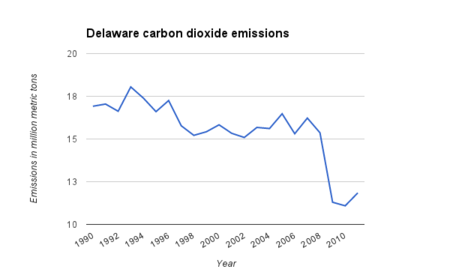 Carbon dioxide emissions in Delaware (in million metric tons). Data was compiled by the U.S. Energy Information Administration. |
Pollution from energy use
Pollution from energy use includes three common air pollutants: carbon monoxide, nitrogen dioxide and ozone. These and other pollutants are regulated by the U.S. Environmental Protection Agency (EPA) through the National Ambient Air Quality Standards, which are federal standards limiting pollutants that can harm human health in significant concentrations. Carbon dioxide, a greenhouse gas, is also regulated by the EPA, but it is excluded here since it is not one of the pollutants originally regulated under the Clean Air Act for its harm to human health.
Industries and motor vehicles emit carbon monoxide directly when they use energy. Nitrogen dioxide forms from the emissions of automobiles, power plants and other sources. Ground level ozone (also known as tropospheric ozone) is not emitted but is the product of chemical reactions between nitrogen dioxide and volatile organic chemicals. The EPA tracks these and other pollutants from monitoring sites across the United States. The data below shows nationwide and regional trends for carbon monoxide, nitrogen dioxide and ozone between 2000 and 2014. States with consistent climates and weather patterns were grouped together by the EPA to make up each region.[38][39]
Carbon monoxide (CO)
Carbon monoxide (CO) is a colorless, odorless gas produced from combustion processes, e.g., when gasoline reacts rapidly with oxygen and releases exhaust; the majority of national CO emissions come from mobile sources like automobiles. CO can reduce the oxygen-carrying capacity of the blood and at very high levels can cause death. CO concentrations are measured in parts per million (ppm). Since 1994, federal law prohibits CO concentrations from exceeding 9 ppm during an eight-hour period more than once per year.[40][41]
The chart below compares the annual average concentration of carbon monoxide in the Northeastern and Southeastern regions of the United States between 2000 and 2014. States with consistent climates and weather patterns are grouped together by the U.S. Environmental Protection Agency (EPA), which collects these data, to make up each region. Each line represents the annual average of all the data collected from pollution monitoring sites in each region. In the Northeast, there were 32 monitoring sites throughout 11 states, compared to 22 monitoring sites throughout six states in the Southeast. In 2000, the average concentration of carbon monoxide was 2.7 ppm in the Northeast, compared to 3.91 ppm in the Southeast. In 2014, the average concentration of carbon monoxide was 1.2 ppm in the Northeast, a decrease of 61.1 percent from 2000, compared to 1.52 ppm in the Southeast, a decrease of 56.7 percent from 2000.[42]
Nitrogen dioxide (NO2)
Nitrogen dioxide (NO2) is one of a group of gasses known as nitrogen oxides (NOx). The U.S. Environmental Protection Agency (EPA) measures NO2 as a representative for the larger group of nitrogen oxides. NO2 forms from the emissions of cars, buses, trucks, power plants, and off-road equipment. It helps form ground-level ozone and fine particle pollution, and has been linked to respiratory problems. Since 1971, federal law prohibits NO2 concentrations from exceeding a daily one-hour average of 100 parts per billion (ppb) and an annual average of 53 parts per billion (ppb).[41][43][41]
The chart below compares the annual one-hour average concentration of nitrogen dioxide (NO2) in the Northeastern and Southeastern regions of the United States between 2000 and 2014. In the Northeast, there were 32 monitoring sites throughout 11 states, compared to 14 monitoring sites throughout six states in the Southeast. In 2000, the one-hour daily average concentration of NO2 was 61.31 ppb in the Northeast, compared to 57 ppb in the Southeast. In 2014, the one-hour daily average concentration of NO2 was 43.98 ppb in the Northeast, a decrease of 28.2 percent since 2000, compared to 38.36 ppb in the Southeast, a decrease of 32.6 percent since 2000.[44]
Ground-level ozone
Ground-level ozone is created by chemical reactions between nitrogen oxides (NOx) and volatile organic compounds (VOCs) in sunlight. Major sources of NOx and VOCs include industrial facilities, electric utilities, automobiles, gasoline vapors, and chemical solvents. Ground-level ozone can produce health problems for children, the elderly, and asthmatics. Since 2008, federal law has prohibited ozone concentrations from exceeding a daily eight-hour average of 75 parts per billion (ppb). Beginning in 2025, federal law will prohibit ground-level ozone concentrations from exceeding a daily eight-hour average of 70 ppb.[41][45]
The chart below compares the daily eight-hour average concentration of ground-level ozone in the Northeastern and Southeastern regions of the United States between 2000 and 2014. In the chart below, ozone concentrations are measured in parts per million (ppm), which can be converted to parts per billion (ppb). In the Northeast, there were 133 monitoring sites throughout 11 states, compared to 153 monitoring sites throughout six states in the Southeast. In 2000, the daily eight-hour average concentration of ozone was 0.083 ppm, or 83 ppb in the Northeast, compared to 0.082 ppm, or 82 ppb in the Southeast. In 2014, the daily eight-hour average concentration of ozone was 0.066 ppm, or 66 ppb in the Northeast, a decrease of 19.5 percent since 2000, compared to 0.063 ppm, or 63 ppb in the Southeast, a decrease of 23.9 percent since 2000.[46]
State laws
The Department of Natural Resources and Environmental Control is responsible for enforcing the environmental laws created by the Delaware State Legislature. The rules, regulations, laws, policies and guidelines the department implements can be found here. These rules cover topics ranging from air quality, to wetlands, sediment and stormwater law, to fisheries, and pollution control.[47]
Enforcement
The Delaware Department of Natural Resources and Environmental Control is responsible for enforcing the state's environmental laws. Its stated mission is as follows:[48]
| “ | It's the mission of the Delaware Department of Natural Resources and Environmental Control to protect and manage the state's vital natural resources, protect public health and safety, provide quality outdoor recreation and to serve and educate the citizens of the First State about the wise use, conservation and enhancement of Delaware's Environment.[49] | ” |
| —Delaware Department of Natural Resources and Environmental Control | ||
Within the department are three offices:
- The Office of the Secretary
- The Office of Environmental Protection
- The Office of Natural Resources
Below are brief descriptions of each office.
- The Office of the Secretary "provides overall direction for the Department." Included within this office is the Division of Energy & Climate, which is attempting to increase Delaware's reliance on reliable, clean energy. The Delaware Coastal Program manages the state's coastlines. The Office of Community Services oversees compliance with local, state and federal environmental programs. The Financial Assistance Branch manages private and federal funding for environmental programs in the state.[50]
- The Office of Environmental Protection is composed of divisions overseeing air quality, waste and hazardous substances, and water. The Division of Air Quality monitors air quality in the state, regulates the emission of certain air pollutants, and oversees vehicle emissions testing, among other programs. The Division of Waste & Hazardous Substances oversees solid and hazardous waste handling in the state. The Division of Water protects the states ground and surface waters.[50]
- The Office of Natural Resources oversees three programs that monitor and manage natural resources in the state. The Division of Fish & Wildlife manages the state's fish and wildlife populations. The Division of Parks & Recreation maintains the state's parks and nature reserves. The Division of Watershed Stewardship manages the state's coastline, water and soil to ensure the stewardship of the state's resources.[50]
Historical budget information
The table below shows the total expenditures on the environment and natural resources in Delaware and in neighboring states.
| Total state natural resource expenditures by state | |||||
|---|---|---|---|---|---|
| State | Departments/Divisions | FY 2013 | FY 2012 | FY 2011 | |
| Delaware | Natural Resources and Environmental Control | $131,880,700 | $131,610,100 | $123,677,800 | |
| Maryland | Environment | $438,614,337 | $242,791,099 | $233,475,248 | |
| Pennsylvania | Environmental Protection; Conservation and Natural Resources | $662,640,000 | $674,941,000 | $677,297,000 | |
| Virginia | Natural Resources | $481,441,541 | $369,447,482 | $400,402,974 | |
| West Virginia | Environmental Protection | $173,414,325 | $178,298,652 | N/A | |
| Sources: Delaware Office of Management and Budget, Maryland Department of Budget and Management, Pennsylvania Office of the Budget, Virginia Department of Planning and Budget, West Virginia State Budget Office | |||||
Major groups
Below is a list of environmental advocacy organizations in Delaware.
- Green Delaware
- Sierra Club - Delaware Chapter
- Nature Conservancy - Delaware Chapter
- Delaware Wild Lands
- Delaware Nature Society
Ballot measures
| Voting on the Environment | ||||
|---|---|---|---|---|

| ||||
| Ballot Measures | ||||
| By state | ||||
| By year | ||||
| Not on ballot | ||||
|
Below is a list of ballot measures relating to environmental issues in Delaware.
Natural resources
Ballotpedia staff have tracked no ballot measures relating to natural resources in Delaware.
Environment
Ballotpedia staff have tracked no ballot measures relating to environment in Delaware.
Water
Ballotpedia staff have tracked no ballot measures relating to water in Delaware.
Recent news
This section links to a Google news search for the term "Delaware+Environmental+Policy"
See also
- Environmental policy in Delaware
- Environmental policy in the United States
- Energy policy in the United States
- Energy policy in Delaware
- Federal land ownership by state
- BLM oil and gas leases by state
- Payments in lieu of taxes
External links
- Delaware Department of Natural Resources and Environmental Control
- U.S. Environmental Protection Agency
Footnotes
- ↑ 1.0 1.1 Congressional Research Service, "Federal Land Ownership: Overview and Data," accessed September 15, 2014
- ↑ U.S. Congressional Research Service, "Federal Lands and Natural Resources: Overview and Selected Issues for the 113th Congress," December 8, 2014
- ↑ State of Delaware Division of Parks and Recreation, "About Us," accessed December 4, 2014
- ↑ U.S. National Park Service, "Delaware Parks," accessed October 10, 2014
- ↑ Delaware State Parks, "Delaware State Parks," accessed December 4, 2014
- ↑ U.S. Bureau of Land Management, "Oil and Gas Lease Sales," accessed October 20, 2014
- ↑ U.S. Bureau of Land Management, "Number of Acres Leased During the Fiscal Year," accessed October 20, 2014
- ↑ U.S. Bureau of Land Management, "Total Number of Leases in Effect," accessed October 20, 2014
- ↑ U.S. Bureau of Land Management, "Summary of Onshore Oil and Gas Statistics," accessed October 20, 2014
- ↑ U.S. Bureau of Land Management, "Number of Drilling Permits Approved by Fiscal Year on Federal Lands," accessed October 20, 2014
- ↑ U.S. Bureau of Land Management, "Total Number of Acres Under Lease As of the Last Day of the Fiscal Year," accessed October 22, 2014
- ↑ U.S. Department of the Interior, "PILT," accessed October 4, 2014
- ↑ U.S. Environmental Protection Agency, "Understanding the Clean Air Act," accessed September 12, 2014
- ↑ U.S. Environmental Protection Agency, "Clean Water Act (CWA) Overview," accessed September 19, 2014
- ↑ The New York Times, "Clean Water Act Violations: The Enforcement Record," September 13, 2009
- ↑ U.S. Fish and Wildlife Service, "Improving ESA Implementation," accessed May 15, 2015
- ↑ U.S. Fish and Wildlife Service, "ESA Overview," accessed October 1, 2014
- ↑ U.S. Fish and Wildlife Service, "Endangered and threatened species in Delaware," accessed July 6, 2015
- ↑ U.S. Fish and Wildlife Service, "Endangered and threatened species in Delaware," accessed July 6, 2015
- ↑ Delaware Division of Fish and Wildlife, "Wildlife Species Conservation & Research Program," accessed July 21, 2015
- ↑ U.S. Environmental Protection Agency, "Annual EPA Enforcement Results Highlight Focus on Major Environmental Violations," February 7, 2014
- ↑ Environmental Protection Agency, "Accomplishments by EPA Region (2013)," May 12, 2014
- ↑ U.S. Environmental Protection Agency, "Enforcement Annual Results for Fiscal Year 2012," accessed October 1, 2014
- ↑ U.S. Environmental Protection Agency, "EPA Enforcement in 2012 Protects Communities From Harmful Pollution," December 17, 2012
- ↑ U.S. Environmental Protection Agency, "Basic Information on Mercury and Air Toxics Standards," accessed January 5, 2015
- ↑ U.S. Environmental Protection Agency, "Cleaner Power Plants," accessed January 5, 2015
- ↑ U.S. Environmental Protection Agency, "Mercury and Air Toxics Standards in Delaware," accessed September 9, 2014
- ↑ U.S. Environmental Protection Agency, "Benefits and Costs of Cleaning Up Toxic Air Pollution from Power Plants," accessed October 9, 2014
- ↑ NERA Economic Consulting, "An Economic Impact Analysis of EPA's Mercury and Air Toxics Standards Rule," March 1, 2012
- ↑ U.S. Environmental Protection Agency, "What is Superfund?" accessed September 9, 2014
- ↑ U.S. Environmental Protection Agency, "National Priorities List (NPL) of Superfund Sites," accessed October 7, 2014
- ↑ U.S. Government Accountability Office, "EPA's Estimated Costs to Remediate Existing Sites Exceed Current Funding Levels, and More Sites Are Expected to Be Added to the National Priorities List," accessed October 7, 2014
- ↑ U.S. Environmental Protection Agency, "Estimate of National Economic Impacts of Superfund Sites," accessed September 12, 2014
- ↑ Property and Environment Research Center, "Superfund Follies, Part II," accessed October 7, 2014
- ↑ Property and Environment Research Center, "Superfund: The Shortcut That Failed (1996)," accessed October 7, 2014
- ↑ U.S. Environmental Protection Agency, "Beneficial Effects of the Superfund Program," accessed September 12, 2014
- ↑ U.S. Energy Information Administration, "State Profiles and Energy Estimates," accessed October 13, 2014
- ↑ U.S. Environmental Protection Agency, "Air Trends," accessed October 30, 2015
- ↑ U.S. Environmental Protection Agency, "Basic Information - Ozone," accessed January 1, 2016
- ↑ U.S. Environmental Protection Agency, "Carbon Monoxide," accessed October 26, 2015
- ↑ 41.0 41.1 41.2 41.3 U.S. Environmental Protection Agency, "National Ambient Air Quality Standards (NAAQS)," accessed October 26, 2015
- ↑ U.S. Environmental Protection Agency, "Regional Trends in CO Levels," accessed October 23, 2015
- ↑ U.S. Environmental Protection Agency, "Nitrogen dioxide," accessed October 26, 2015
- ↑ U.S. Environmental Protection Agency, "Regional Trends in Nitrogen Dioxide Levels," accessed October 23, 2015
- ↑ U.S. Environmental Protection Agency, "Ground Level Ozone," accessed October 26, 2015
- ↑ U.S. Environmental Protection Agency, "Regional Trends in Ozone Levels ," accessed October 26, 2015
- ↑ State of Delaware, "Rules, Regulations, Laws, Policies, and Guidelines," accessed December 17, 2014
- ↑ Delaware Department of Natural Resources and Environmental Control, "About DNREC," accessed December 4, 2014
- ↑ Note: This text is quoted verbatim from the original source. Any inconsistencies are attributable to the original source.
- ↑ 50.0 50.1 50.2 State of Delaware, "Delaware Department of Natural Resources and Environmental Control," accessed December 17, 2014




